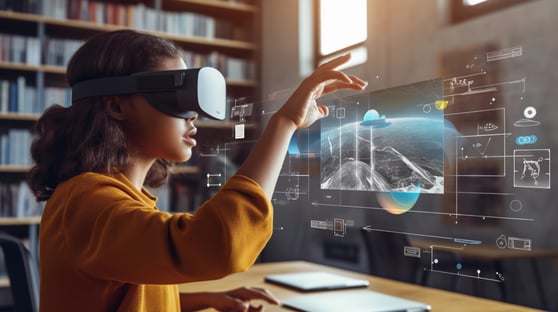
Why is Hands On Learning Important for Elementary Schools
You know the moment: a student’s eyes light up when the science experiment fizzes or the math puzzle helps them...
ALI Staff | Published August 08, 2023
It’s beyond time to talk about the impact of AI education in the classroom. Artificial intelligence is already here. Students and teachers are using it in daily life with varying degrees of success.
If students want to keep up with a changing landscape, it’s less important to identify the cons of AI as it is to talk about acceptable, even positive, uses. We can say the same for our teachers.
Artificial intelligence will never replace solid teaching experience. Teachers will always know their students best. What it might do is make it more important to reach students on a level untouched by AI.
These are the real, human skills students develop by making connections in the classroom and being exposed to hands-on learning. All of that can still happen while we figure out how to use AI to our advantage.

It’d be naive to say that artificial intelligence hasn’t already affected student learning.
Educators worry about an overreliance on AI to complete work that once required more brainpower. They’re worried about inaccurate, even biased, information in student work.
On a broader level, AI could further disadvantage students who already lack access to more basic technology.
It could affect social-emotional learning in younger students who haven’t developed skills around intuition that come from human interaction. While AI can make work more efficient, it can also hamper creativity.
That all said, educators and students are already using it, especially at the college level.
A survey this year of college students from the online magazine Intelligent showed that nearly a third of college students had already used ChatGPT to complete written assignments. About 60% of those students used the AI program on more than half of their homework.
If assignments are so easily completed by AI technology, that could be an opportunity for educators to look at student learning differently. How can we assess student learning in a more individualized way?
It has also created more teachable moments to present the good with the bad. If students aren’t using these tools correctly, perhaps it’s time to teach them how to do things differently.
What can we do to support student learning and promote a new way of learning that accounts for AI?
We hear a lot about the pitfalls of artificial intelligence for education, but AI is already being used in various ways to make tasks more efficient and effective.
On the teacher side, educators are using AI to:
AI is about more than chatbots. These lists only scratch the surface of AI capabilities.
Schools that embrace the potential of AI while acknowledging the challenges will be better equipped to prepare students for the outside world and engage students along the way.
Advancements in AI could make education more individualized as long as it’s used in the right ways.
It could benefit students who don’t fit into the usual learning styles or who need additional practice with tough concepts. It could make learning more engaging, especially when student interests are thrown into the mix.
For teachers, that all would mean improved learning outcomes. It could simplify access to student interventions and make it easier for students with needs to participate in classroom activities.
If we ignore AI completely, these tech advancements could have the opposite effect. Students could continue using these tools in isolation without understanding AI’s effects on their learning.
Teachers could continue struggling to keep up with tools that attempt to catch AI in student writing. That takes resources away from students and teachers.
It doesn’t all have to be bad news. The trend of AI in schools can be an opportunity to be more creative about learning objectives that are just as valuable for students.
As it stands now, more and more students are leaving school feeling unprepared for the real world. Research completed this year from the Cengage Group showed that 65% of recent grads want to train with AI and other new technologies to be better prepared for the workforce. Nearly half of those grads feel threatened by AI.
This isn’t only an AI problem. It’s a failure to adapt to a changing landscape that includes artificial intelligence. No matter what’s on the horizon, successful programs will prepare students to compete on a higher level. AI can’t replace every aspect of education.
Here are some examples:
Students will always need teacher support. AI can’t replace a good mentor or role model, no matter how good it gets. Students will always benefit from real connections with those who care and know the most about them.
Ignoring AI altogether isn’t the way to go if the goal is to prepare students for what’s ahead. It shouldn’t even be the goal if schools want to address gaps due to learning loss or other challenges faced by educators today.
The challenges of AI are real, but so are the possibilities. It’s all about balance. There are ways to use these technologies to boost students’ skill sets, improve their digital literacy, and prepare them for the future.

You know the moment: a student’s eyes light up when the science experiment fizzes or the math puzzle helps them...

STEM classrooms are full of different types of learners in the classroom, each with their own strengths and needs.
...

Algebra 1 is one of the most pivotal courses in a student’s math journey.